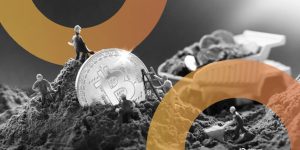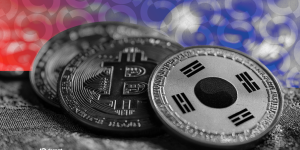
There’s no doubt that the crypto industry is at an inflection point. In the past months, a series of scandals—including bankruptcy, insider trading, and unorthodox withdrawals—have rocked fragile confidence in its ecosystem.
Rana Kortam, global policy lead at Binance, told Decrypt that “the challenges have definitely underscored the need to do more,” and insists that “we all have a part to play,” to provide further protections for users and investors, and build for the long term.
In the U.S. and elsewhere, authorities have cracked down on individuals and firms they consider to be in breach of regulations with criminal proceedings and hefty fines. In Europe, banks were told to assign crypto the highest possible risk rating, and cap their holdings—demonstrating that the confidence crisis is still unfolding. Centralized crypto exchanges (CEXs), where user funds can be stored, have been impacted most by the crisis.
Building trust
Binance, the biggest CEX by trading volume globally, was one of the first to recognize the colossal challenge the industry faces.
Throughout last year, the firm began introducing measures around transparency and trust, culminating in a new, actionable framework of guidelines for centralized exchanges, and for the broader community to use (should they wish to do so), and accompanied by a dedicated Building Trust landing page.
Centralised exchanges play a key role in this industry.#Binance is working towards bringing more transparency, trust and security to the space and we feel that a joint effort is needed to accelerate this further.
Read our guidelines in the blog below. https://t.co/c9c2AgVCyS
— Binance (@binance) February 16, 2023
First and foremost, the guidelines deal with the handling of customer assets; they describe what every centralized exchange should do in terms of transparency—including the kind of disclosures that can be expected and the guardrails that CEXs can put in place, in addition to those mandated by regulation.
The framework is designed to be useful for users and policymakers in the broader industry, as well as centralized and decentralized exchanges, and Kortam hopes to elicit community feedback from all of these groups so that the industry “can continue to raise the bar.”
Informing this effort is the building trust landing page, a place where Binance users can see all the new measures that have been implemented, including the different proof of reserves systems; a walkthrough of how to check their own reserves and Binance’s on-chain reserves, as well as its wallet addresses, educational materials, and details of where it is regulated and what “licenses, registrations or other regulatory approvals we have,’ explained Kortam.
The area is a living hub for material related to trust and transparency. Additional content or future iterations of guidelines, new policy papers on regulation, regulatory best practices, and much else besides.
Kortam, whose background in public policy and public affairs includes stints at tech giants Google and Uber, as well as the rapidly expanding global fintech Revolut, is keen to point out that Binance doesn’t claim to have all the answers.
Its proposed framework, launched last week, is not the end but the beginning of the journey, particularly in transparency and wallet security. It’s also designed to work hand in hand with regulations, which are necessary “to address specific risk-based issues in a way that mitigates bad actors, protects users, and enables innovation,” she added.
ZK and you shall find
Binance’s efforts to enhance trust and transparency took on additional momentum in November 2022, when the exchange published its wallet addresses, “so the community can verify that we have sufficient holdings of user funds in our reserves,” Kortam explained.
In November 2022, the exchange introduced the first version of a proof of reserves system that relies on Merkle Trees, a technology that allows blockchains to be more efficient and trustworthy by organizing data in a certain way, thus giving users a new tool to verify that their assets are in the safekeeping of Binance if they choose to store them online.
The exchange’s self-custody solutions, such as Trust Wallet, were upgraded with additional enhancements and security features, and Binance published a wealth of content around “different wallet options; different security and custody solutions available to our customers,” Kortam said.
The system is evolving, too. In November 2022, Binance CEO Changpeng “CZ” Zhao revealed that the exchange would be a “guinea pig” for a new proof of reserves protocol developed by none other than Ethereum co-founder Vitalik Buterin.
This February, mere months after it introduced proof of reserves, Binance upgraded to a new open-source system using zk-SNARKs, a technology that has been the cornerstone of innovation in blockchain. The technology enables crypto users to send transactions on a blockchain in a totally encrypted way while demonstrating that they happened in a legitimate manner.
They represent a significant improvement over Binance’s previous proof of reserves system, Kortam said. Notably, the new system can demonstrate that all user balances in Binance’s custody add up to the claimed total, she explained. Thus, “proving that we do have all user balances in custody; we hold reserves and user assets, one to one, and it can also verify that the total balance of any single user cannot be negative, which was one of the shortcomings of the earlier solution,” she added.
Back to school
A lot of Binance’s work on trust revolves around education. The exchange has around 400 articles and videos, as well as free online courses on its Binance Academy website, and has partnered with universities throughout the world for targeted programs. Much of its educational content is open source.
Other companies, and even law enforcement agencies, have made use of these resources for training purposes, says Kortam. The exchange has also worked with them directly, she adds.
“The more FUD, the more we need to do better on education, and on trust,” Kortam said. She explained that users need to see their balances are safe and that centralized exchanges can honor withdrawals of assets held in their custody.
Community feedback
The measures Binance has taken already are part of a wider effort to increase trust in the crypto industry, Kortam said. The exchange is already working with other industry players, as well as various associations and community leaders, to increase trust, she says.
This community was quick to provide feedback on the exchange’s most recent proof of reserves innovation, which is open-source so that it can easily be adopted or adapted, and Binance has already acted on some of the feedback.
“We don’t believe that trust or safety are proprietary,” said Kortam. “Every company, every player has the same duty to build trust in the industry and raise the bar across the board.”
Sponsored post by Binance
This sponsored article was created by Decrypt Studio. Learn More about partnering with Decrypt Studio.















